Fluoride Sorption Efficiency of Vermiculite Functionalised with Cationic Surfactant: Isotherm and Kinetics
Abstract
:1. Introduction
2. Materials and Methods
2.1. Materials
2.2. Preparation of Surfactant-Modified Vermiculite
2.3. Characterisation of Adsorbent
2.4. Batch Adsorption Experiments
3. Results
3.1. Effect of HDTMA Strength
3.2. Fourier Transform Infrared
3.3. Scanning Electron Microscopy
3.4. Optimisation of Experimental Parameters Using HDTMA-VMT0.2M
3.4.1. Effect of Agitation Time
3.4.2. Effect of Adsorbent Dosage
3.4.3. Effect of Adsorbate Dosage
3.4.4. Effect of pH
3.4.5. Effect of Temperature
3.5. Adsorption Isotherm
3.6. Adsorption Kinetics
3.7. Mechanism-Based Model
4. Conclusions
Acknowledgments
Author Contributions
Conflicts of Interest
References
- Parlikar, A.S.; Mokashi, S.S. Defluoridation of water by moringa oleifera—A natural adsorbent. Int. J. Eng. Sci. Innov. Technol. 2013, 2, 245–252. [Google Scholar]
- World Health Organisation. Fluoride in Drinking-Water, Background Document for Development of WHO Guidelines for Drinking-Water Quality; World Health Organization: Geneva, Switzerland, 2004. [Google Scholar]
- Kamble, S.P.; Japtap, S.; Labhsetwar, N.K.; Thakare, D.; Godfrey, S.; Devotta, S.; Rayau, S.S. Defluoridation of drinking water using chitin, chitosan and lanthanum modified chitosan. Chem. Eng. J. 2007, 129, 173–180. [Google Scholar] [CrossRef]
- Atia, D.; Hoggui, A. Defluoridation of water by precipitation. J. Chem. Pharm. Res. 2012, 4, 5180–5184. [Google Scholar]
- Patil, S.P.; Ingole, N.W. Studies on defluoridation—A critical review. J. Eng. Res. Stud. 2012, 3, 111–119. [Google Scholar]
- Kumar, N.P.; Kumar, N.S.; Krishnaiah, A. Defluoridation of water using tamarind (Tamarindus indica) fruit cover: Kinetics and equilibrium studies. J. Chil. Chem. Soc. 2012, 57, 1224–1231. [Google Scholar] [CrossRef]
- Karthikeyan, M.; Kumar, K.K.; Elango, K.P. Studies on the defluoridation of water using conducting polymer/montmorillonite composites. Environ. Technol. 2012, 33, 733–739. [Google Scholar] [CrossRef] [PubMed]
- Gogoi, P.K.; Baruah, R. Fluoride removal from water by adsorption on acid activated kaolinite clay. Indian J. Chem. Technol. 2008, 15, 500–503. [Google Scholar]
- Sajidu, S.M.I.; Masamba, W.R.L.; Thole, B.; Mwatseteza, J.F. Groundwater fluoride levels in Villages of Southern Malawi and removal studies using bauxite. Int. J. Phys. Sci. 2008, 3, 1–11. [Google Scholar]
- Jain, A.; Singh, S.K. Defluoridation of water using alum impregnated brick powder and its comparison with brick powder. Int. J. Eng. Sci. Innov. Technol. 2014, 3, 591–596. [Google Scholar]
- França, S.C.A.; Arruda, G.M.; Ugarte, J.F.O. Vermiculite utilization on the treatment of water contaminated with organic compounds. In Proceedings of the Enpromer 2005, 2nd Mercosur Congress on Chemical Engineering, Rio de Janeiro, Brazil, 14–18 August 2005.
- Dizadji, N.; Rashtchi, M.; Dehpouri, S.; Nouri, N. Experimental investigation of adsorption of copper from aqueous solution using vermiculite and clinoptilolite. Int. J. Environ. Res. 2013, 7, 887–894. [Google Scholar]
- Hongo, T.; Yoshino, S.; Yamazaki, A.; Yamasaki, A.; Satokawa, S. Mechanical treatment of vermiculite in vibration milling and its effects on lead (II) adsorption ability. Appl. Clay Sci. 2012, 70, 74–78. [Google Scholar] [CrossRef]
- Ramirez-Valle, V.; Jimenez de Haro, M.C.; Aviles, M.A.; Perez-Maqueda, L.A.; Duran, A.; Pascual, J.; Perez-Rodriguez, J.L. Effect of interlayer cations on high-temperature phases of vermiculite. J. Therm. Anal. Calorim. 2006, 84, 147–155. [Google Scholar] [CrossRef]
- Vazquez, A.; Lopez, M.; Kortaberria, G.; Martin, L.; Mondragon, I. Modification of montmorillonite with cationic surfactant. Thermal and chemical analysis including determination of CEC determination. Appl. Clay Sci. 2008, 41, 24–36. [Google Scholar] [CrossRef]
- Vujakovi, A.; Daković, A.; Lemić, J.; Radosavljević-Mihajlović, A.; Tomašević-Canović, M. Adsorption of inorganic anionic contaminants on surfactant modified minerals. J. Serbian Chem. Soc. 2003, 68, 833–841. [Google Scholar] [CrossRef]
- Yu, X.; Wei, C.; Ke, L.; Hu, Y.; Xie, X.; Wu, H. Development of organovermculite-based adsorbent for the removal of anionic dyes from aqueous solution. J. Hazard. Mater. 2010, 180, 499–507. [Google Scholar] [CrossRef] [PubMed]
- Abate, G.; Masini, J.C. Sorption of atrazine, propazine, deethylatrazine, deisopropylatrazine and hydroxyatrazine onto organovermiculite. J. Braz. Chem. Soc. 2005, 16, 936–943. [Google Scholar] [CrossRef]
- Aroke, U.O.; El-Nafaty, U.A.; Osha, O.A. Removal of oxyanion contaminants from wastewater by sorption onto HDTMA-Br surface modified organo-kaolinite clay. Int. J. Emerg. Technol. Adv. Eng. 2014, 4, 475–484. [Google Scholar]
- Onyango, M.S.; Masukume, M.; Ochieng, A.; Otieno, F. Functionalised natural zeolite and its potential for treating drinking water containing excess amount of nitrate. Water SA 2010, 36, 655–662. [Google Scholar] [CrossRef]
- Ahmed, M.E.I. Cadmium adsorption on HDTMA modified montmorillionite. J. Eng. Res. 2009, 6, 8–14. [Google Scholar]
- Radojevic, M.; Bashkin, V.N. Practical Environmental Analysis; The Royal Society of Chemistry: Cambridge, UK, 1999; p. 466. [Google Scholar]
- Senturk, H.B.; Ozdes, D.; Gundogdu, A.; Duran, C.; Soylak, M. Removal of phenol from aqueous solutions by adsorption onto organomodified Tirebolu bentonite: Equilibrium, kinetic and thermodynamic study. J. Hazard. Mater. 2009, 172, 353–362. [Google Scholar] [CrossRef] [PubMed]
- Swarnkar, V.; Agrawal, N.; Tomar, R. Sorption of chromate and arsenate by surfactant modified erionite (E-SMZ). J. Dispers. Sci. Technol. 2012, 33, 919–927. [Google Scholar] [CrossRef]
- Li, Z.; Bowman, R.S. Counterion effects on the sorption of cationic surfactant and chromate on natural clinoptilolite. Environ. Sci. Technol. 1997, 31, 2407–2412. [Google Scholar] [CrossRef]
- Asgari, G.; Roshani, B.; Ghanizadeh, G. The investigation of kinetic and isotherm of fluoride adsorption onto functionalize pumice stone. J. Hazard. Mater. 2012, 217–218, 123–132. [Google Scholar] [CrossRef] [PubMed]
- Muiambo, F.H. Inorganic Modification of Palabora Vermiculite. Master’s Dissertation, University of Pretoria, Pretoria, South Africa, February 2011. [Google Scholar]
- Wang, M.; Liao, L.; Zhang, X.; Li, Z.; Xia, Z.; Cao, W. Adsorption of low-concentration ammonium onto vermiculite from Hebei Province, China. Clays Clay Miner. 2011, 59, 459–465. [Google Scholar] [CrossRef]
- Slimani, M.S.; Ahlafi, H.; Moussout, H.; Chfaira, R.; Zegaoui, O. Evaluation of kinetic and thermodynamic parameters of chromium adsorption on a organobentonite. Int. J. Adv. Res. Chem. Sci. 2014, 1, 17–29. [Google Scholar]
- Dang-I, A.Y.; Boansi, A.O.; Pedevoah, M. Reduction of fluorine in water using clay mixed with hydroxyapatite. Int. J. Appl. Sci. Technol. 2015, 5, 45–55. [Google Scholar]
- Thakre, D.; Rayalu, S.; Kawade, R.; Meshram, S.; Subrt, J.; Labhsetwar, N. Magnesium incorporated bentonite clay for defluoridation of drinking water. J. Hazard. Mater. 2010, 180, 122–130. [Google Scholar] [CrossRef] [PubMed]
- Yilmaz, A.E.; Fil, B.A.; Bayar, S.; Karakaş, Z.K. A new adsorbent for fluoride removal: The utilization of sludge waste from electrocoagulation as adsorbent. Glob. Nest J. 2015, 17, 186–197. [Google Scholar]
- PaliShahjee; Godboley, B.J.; Sudame, A.M. Removal of fluoride from aqueous solution by using low cost adsorbent. Int. J. Innov. Res. Sci. Eng. Technol. 2013, 2, 2721–2725. [Google Scholar]
- Rajkumar, S.; Murugesh, S.; Sivasankar, V.; Darchen, A.; Msagati, T.A.M.; Chaabane, T. Low-cost fluoride adsorbents prepared from a renewable biowaste: Syntheses, characterization and modelling studies. Arab. J. Chem. 2015. [Google Scholar] [CrossRef]
- Dada, A.O.; Olalekan, A.P.; Olatunya, A.M.; Dada, O. Langmuir, Freundlich, Temkin and Dubinin–Radushkevich isotherms studies of equilibrium sorption of Zn2+ unto phosphoric acid modified rice husk. J. Appl. Chem. 2012, 3, 38–45. [Google Scholar]
- Harikumar, P.S.P.; Jaseela, C.; Megha, T. Defluoridation of water using biosorbents. Sci. Res. 2012, 4, 245–251. [Google Scholar] [CrossRef]
- Achmad, A.; Kassim, J.; Suan, T.K.; Amat, R.C.; Seey, T.L. Equilibrium, kinetic and thermodynamic studies on the adsorption of a direct dye onto a novel green adsorbent developed from Uncaria gambir extract. J. Phys. Sci. 2012, 23, 1–13. [Google Scholar]
- Gopal, V.; Elango, K.P. Studies on defluoridation of water using magnesium titanate. Indian J. Chem. Technol. 2010, 17, 28–33. [Google Scholar]
- Ma, Y.; Shi, F.; Zheng, X.; Ma, J.; Gao, C.J. Removal of fluoride from aqueous solution using granular acid-treated bentonite (GHB): Batch and column studies. J. Hazard. Mater. 2011, 185, 1073–1080. [Google Scholar] [CrossRef] [PubMed]
- Malakootian, M.; Moosazadeh, M.; Yousefi, N.; Fatehizadeh, A. Fluoride removal from aqueous solution by pumice: Case study on Kuhbonan water. Afr. J. Environ. Sci Technol. 2011, 5, 299–306. [Google Scholar]
- Gómez-Hortigüela, L.; Pérez-Pariente, J.; García, R.; Chebude, Y.; Díaz, I. Natural zeolites from Ethiopia for elimination of fluoride from drinking water. Sep. Purif. Technol. 2013, 120, 224–229. [Google Scholar] [CrossRef]
- Malakootian, M.; Fatehizadeh, A.; Yousefi, N.; Ahmadian, M.; Moosazadeh, M. Fluoride removal using regenerated spent bleaching earth (RSBE) from groundwater: Case study on Kuhbonan water. Desalination 2011, 277, 244–249. [Google Scholar] [CrossRef]
- Swain, S.K.; Patnaik, T.; Patnaik, P.C.; Jha, U.; Dey, R.K. Development of new alginate entrapped Fe (III)–Zr (IV) binary mixed oxide for removal of fluoride from water bodies. Chem. Eng. J. 2013, 215–216, 763–771. [Google Scholar] [CrossRef]
- Fufa, F.; Alemayehu, E.; Deboch, B. Defluoridation of groundwater using gypsiferous limestone. J. Environ. Occup. Sci. 2014, 3, 71–76. [Google Scholar] [CrossRef]
- Liu, Q.; Guo, H.; Shan, Y. Adsorption of fluoride on synthetic siderite from aqueous solution. J. Fluor. Chem. 2010, 131, 635–641. [Google Scholar] [CrossRef]
- Srivastav, A.L.; Singh, P.K.; Srivastava, V.; Sharma, Y.C. Application of a new adsorbent for fluoride removal from aqueous solutions. J. Hazard. Mater. 2013, 263, 342–352. [Google Scholar] [CrossRef] [PubMed]
- Chen, N.; Zhang, Z.; Feng, C.; Li, M.; Zhu, D.; Sugiura, N. Studies on fluoride adsorption of iron-impregnated granular ceramics from aqueous solution. Mater. Chem. Phys. 2011, 125, 293–298. [Google Scholar] [CrossRef]
- Chen, L.; Wu, H.; Wang, T.; Jin, Y.; Zhang, Y.; Dou, X. Granulation of Fe–Al–Ce nano-adsorbent for fluoride removal from drinking water by spray coating on sand in a fluidized bed. Powder Technol. 2009, 193, 59–64. [Google Scholar] [CrossRef]
- Hernández-Montoya, V.; Ramírez-Montaya, L.A.; Bonilla-Petriciolet, A.; Montes-Morán, M.A. Optimizing the removal of fluoride from water using new carbons obtained by modification of nut shell with a calcium solution from egg shell. Biochem. Eng. J. 2012, 62, 1–7. [Google Scholar] [CrossRef]
- Sun, Y.; Fang, Q.; Dong, J.; Cheng, X.; Xu, J. Removal of fluoride from drinking water by natural stilbite zeolite modified with Fe (III). Desalination 2011, 277, 121–127. [Google Scholar] [CrossRef]
- Rangel-Mendez, J.R.; Barrios, V.A.E.; Davila-Rodriguez, J.L. Chitin Based Biocomposites for Removal of Contaminants from Water: A Case Study of fluoride adsorption. In Biopolymers; Elnashar, M., Ed.; InTech: Rijeka, Croatia, 2010; ISBN 978-953-307-109-1. [Google Scholar]
- Mwakabona, H.T.; Said, M.; Machunda, R.L.; Njau, K.N. Plant biomasses for defluoridation appropriateness: Unlocking their potentials. Res. J. Eng. Appl. Sci. 2014, 3, 167–174. [Google Scholar]
- Hameed, B.H.; Mahmoud, D.K.; Ahmad, A.L. Equilibrium modelling and kinetic studies on the adsorption on basic dye by a low cost adsorbent: Coconut (Cocos nucifera) bunch waste. J. Hazard. Mater. 2008, 158, 65–72. [Google Scholar] [CrossRef] [PubMed]
- Kumar, P.S.; Vincent, C.; Kirthik, K.; Kumar, K.S. Kinetics and equilibrium studies of Pb2+ ion removal from aqueous solutions by use of nano-silversol-coated activated carbon. Braz. J. Chem. Eng. 2010, 27, 339–346. [Google Scholar] [CrossRef]
- Guan, H.; Bestland, E.; Zhu, C.; Zhu, H.; Albertsdottir, D.; Hutson, J.; Simmons, C.T.; Ginic-Markovic, M.; Tao, X.; Ellis, A.V. Variation in performance of surfactant loading and resulting nitrate removal among four selected natural zeolites. J. Hazard. Mater. 2010, 183, 616–621. [Google Scholar] [CrossRef] [PubMed]
- Haggerty, G. Sorption of Inorganic Oxyanions by Organo Zeolite. Master’s Thesis, New Mexico Institute of Mining and Technology, Socorro, NM, USA, 1993. [Google Scholar]
- Weber, W.J., Jr.; Morris, J.C. Kinetics of adsorption on carbon from solution. J. Sanit. Eng. Div. 1963, 89, 31–60. [Google Scholar]
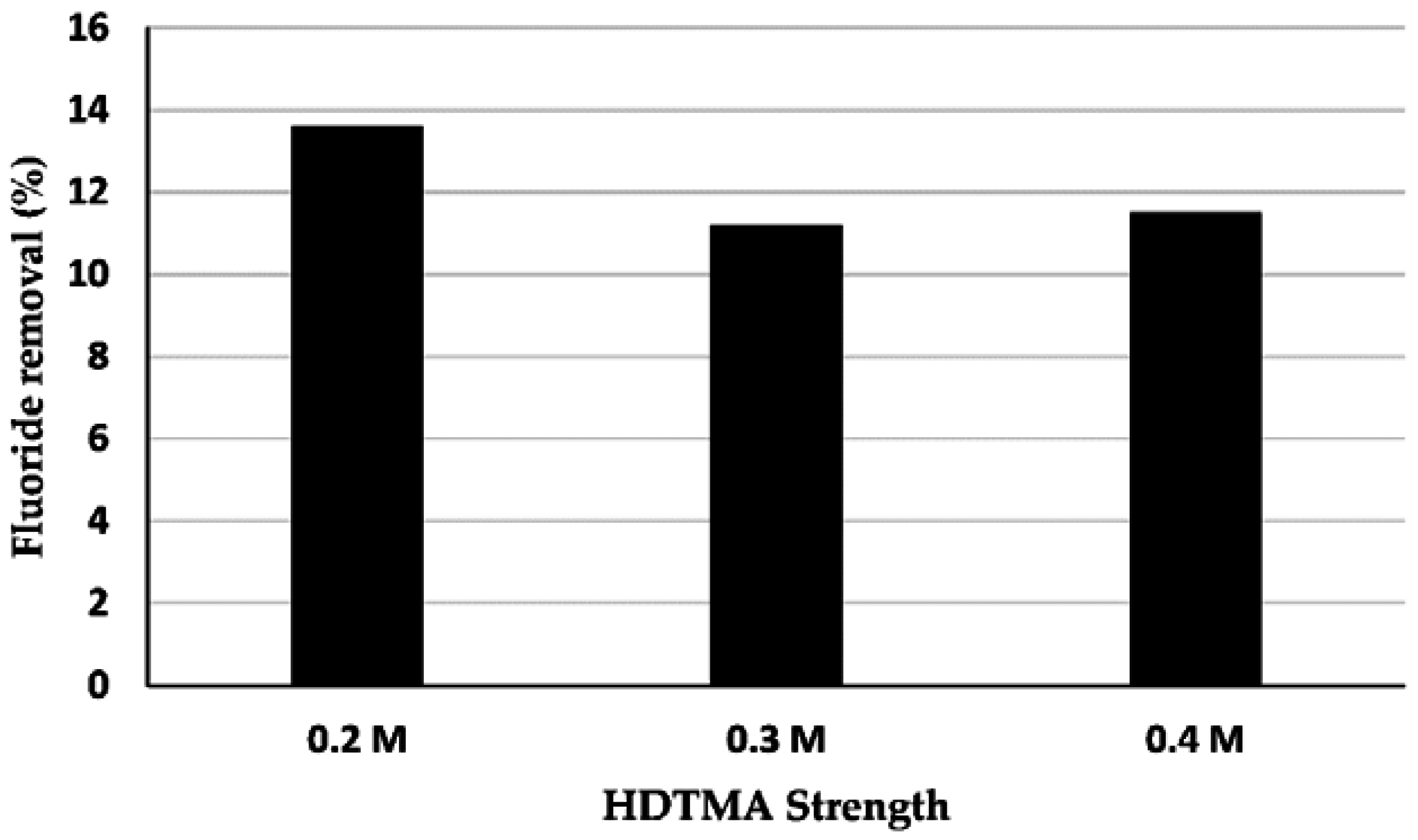

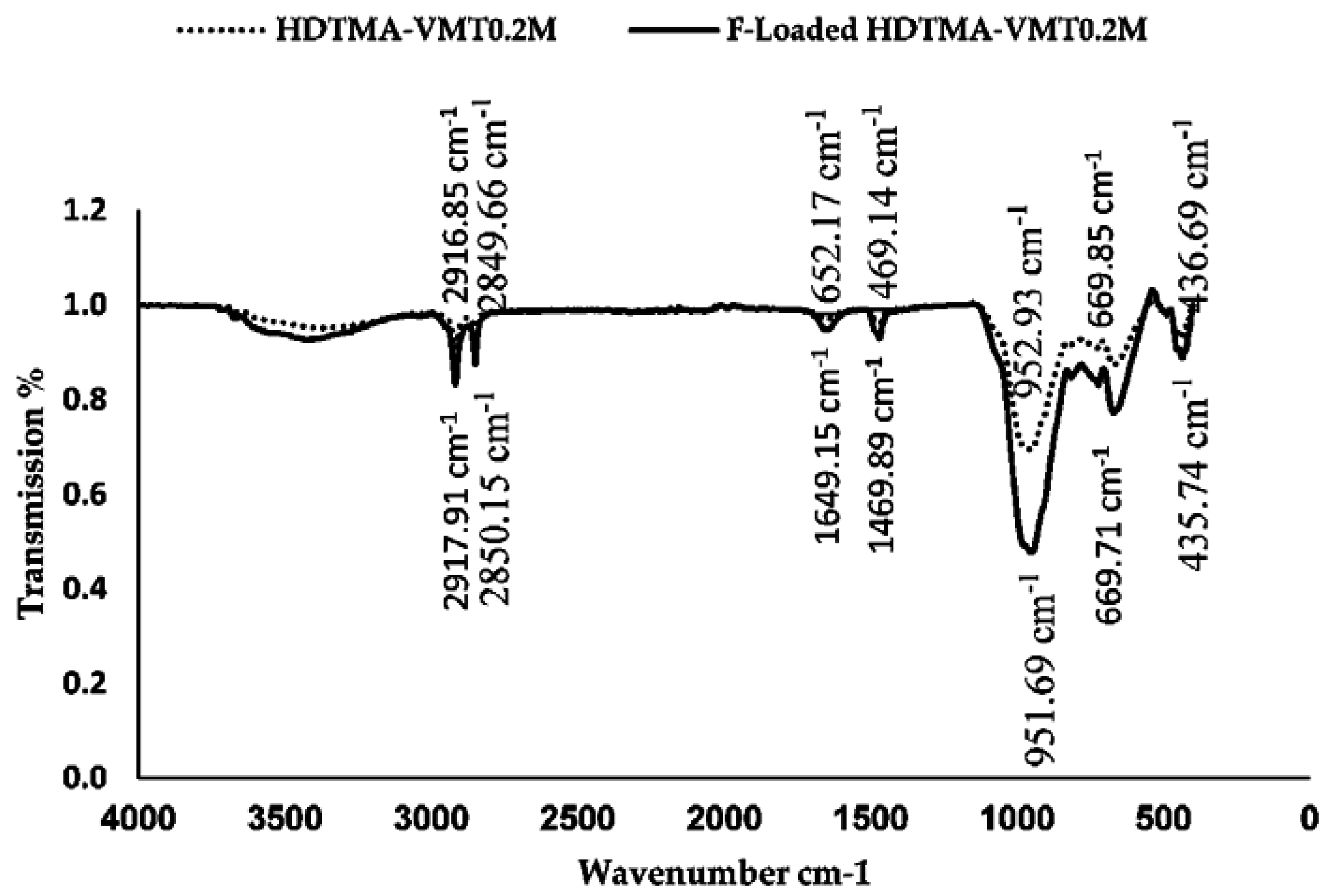
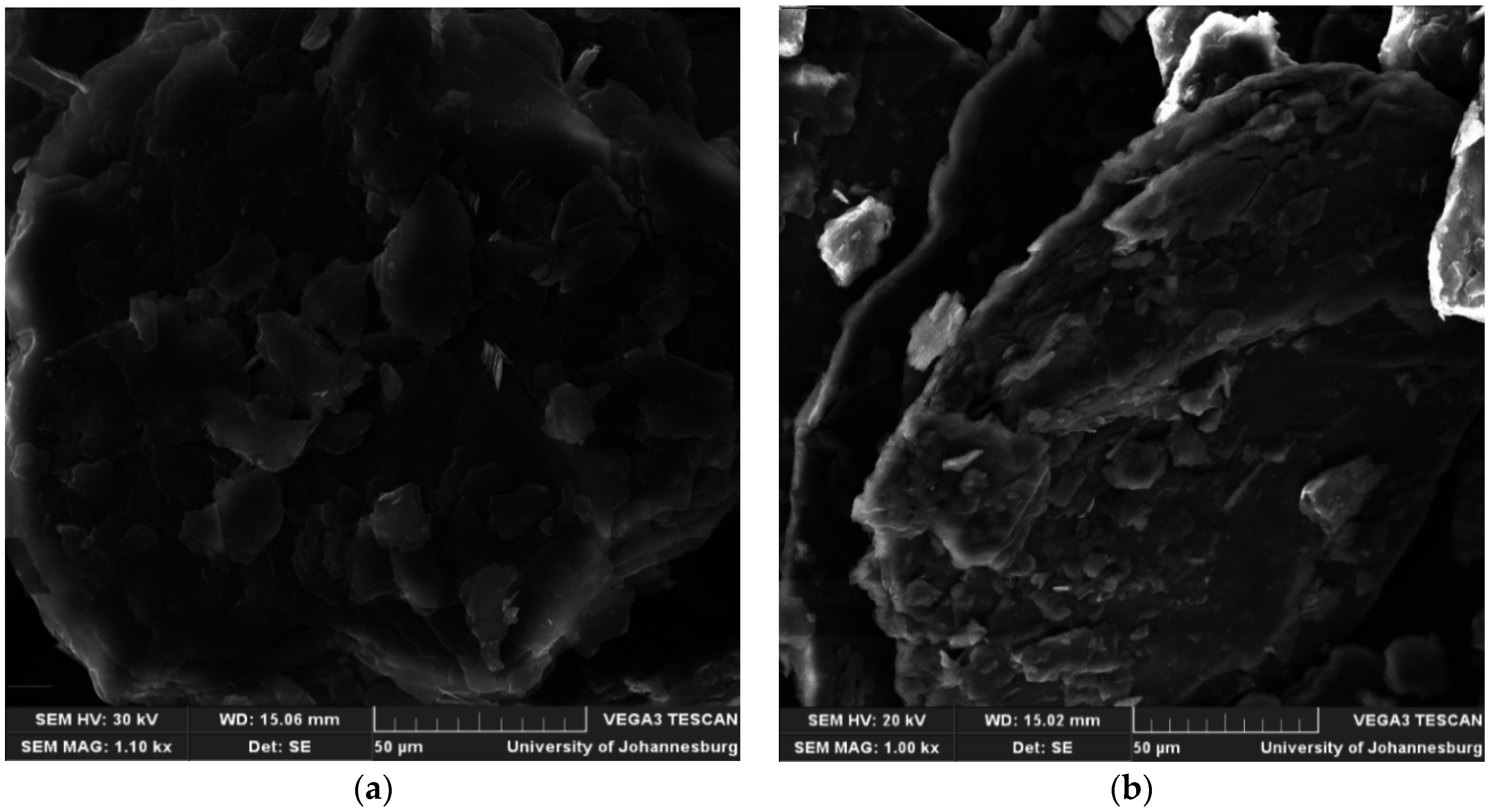
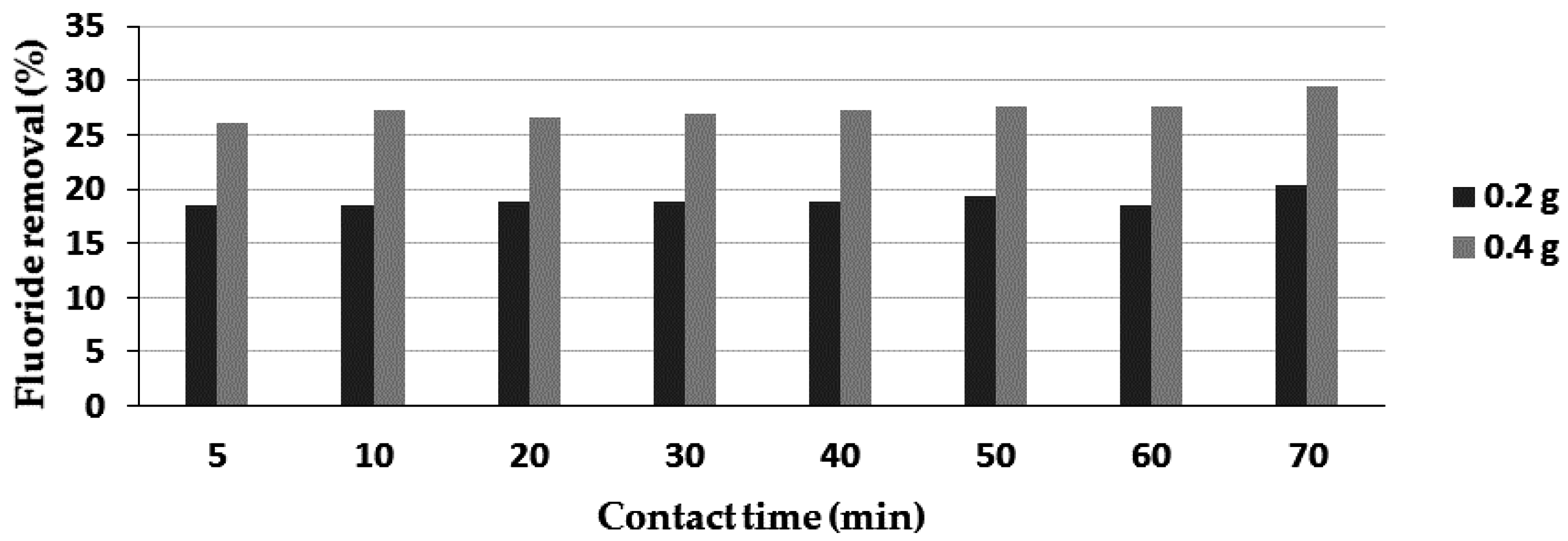

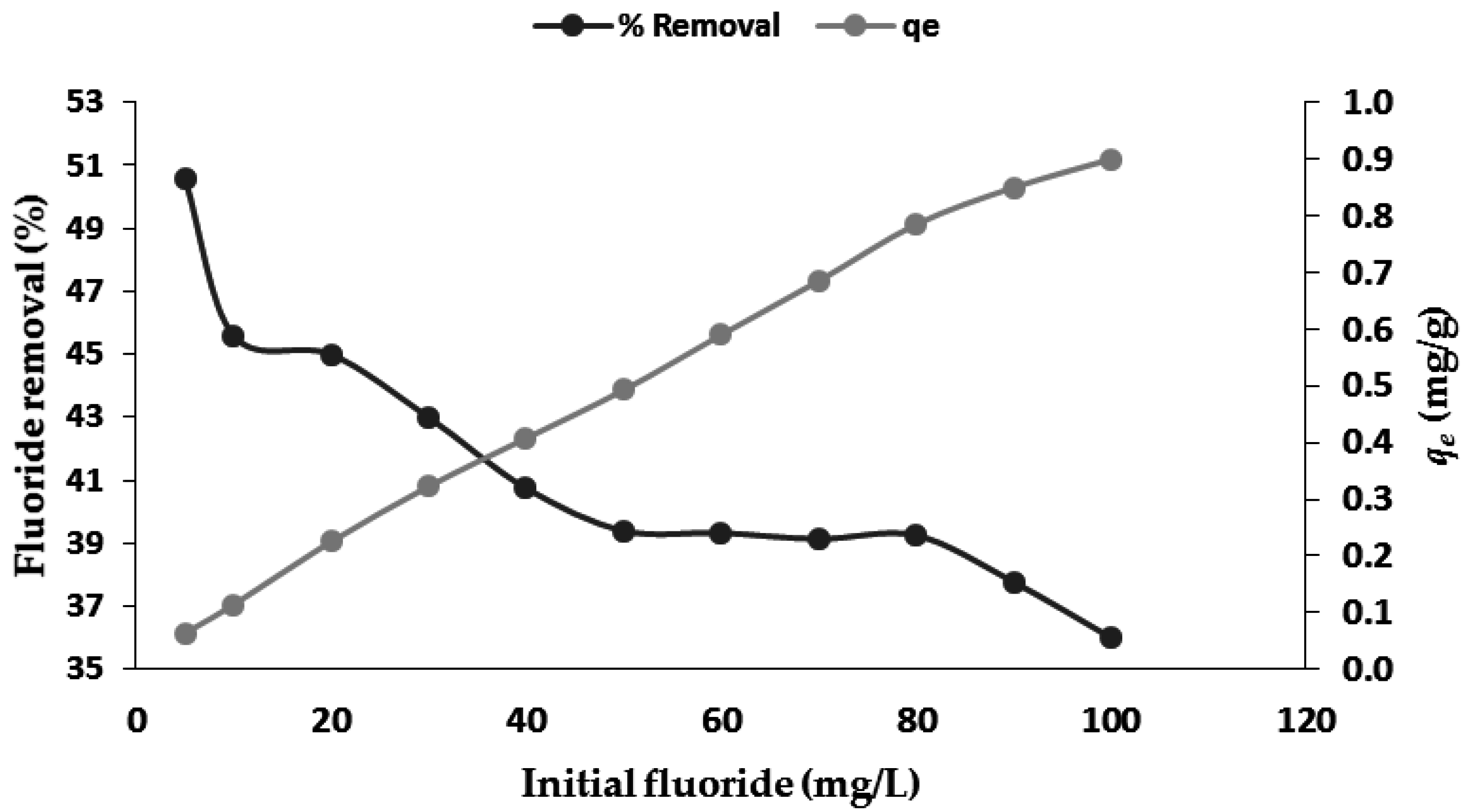

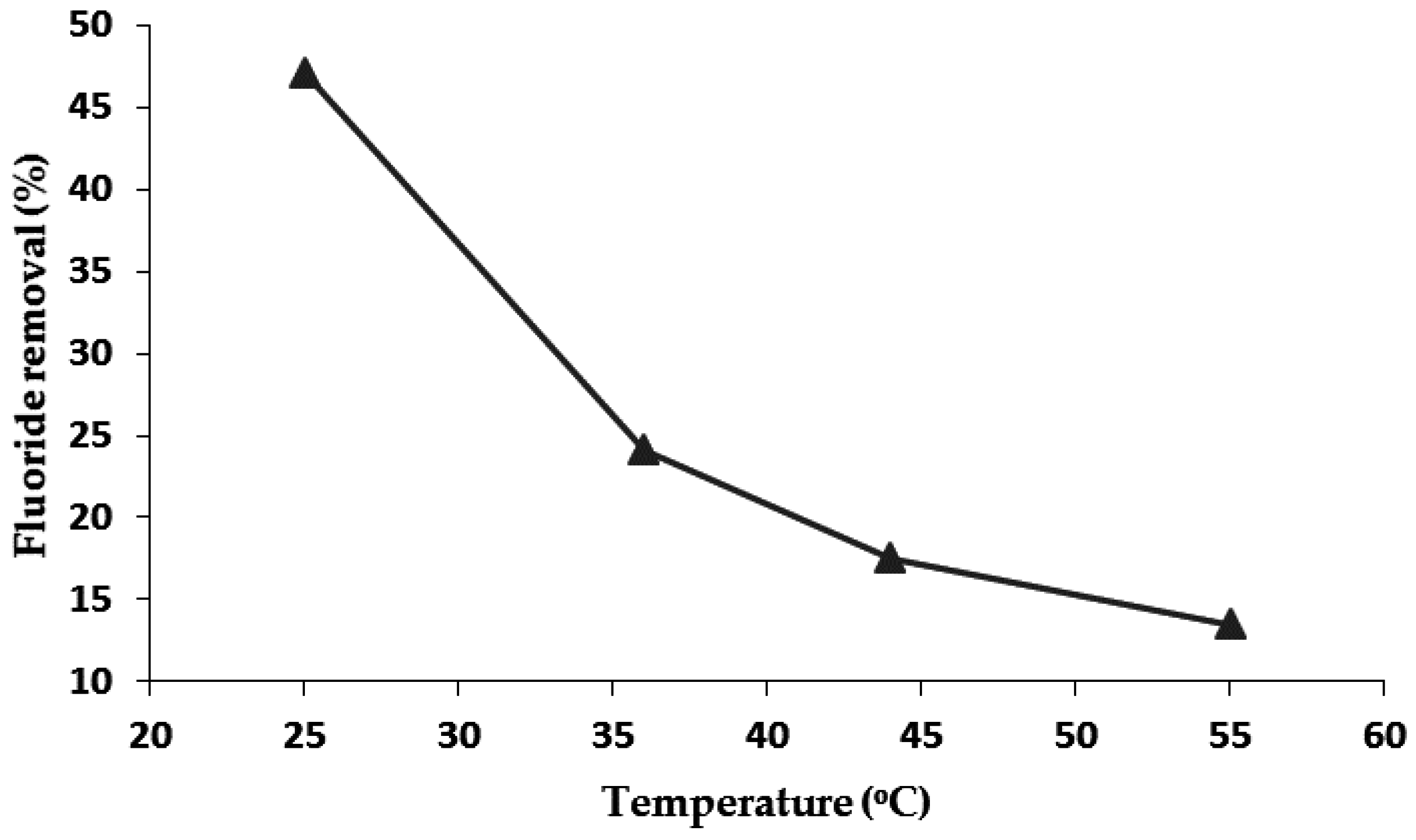

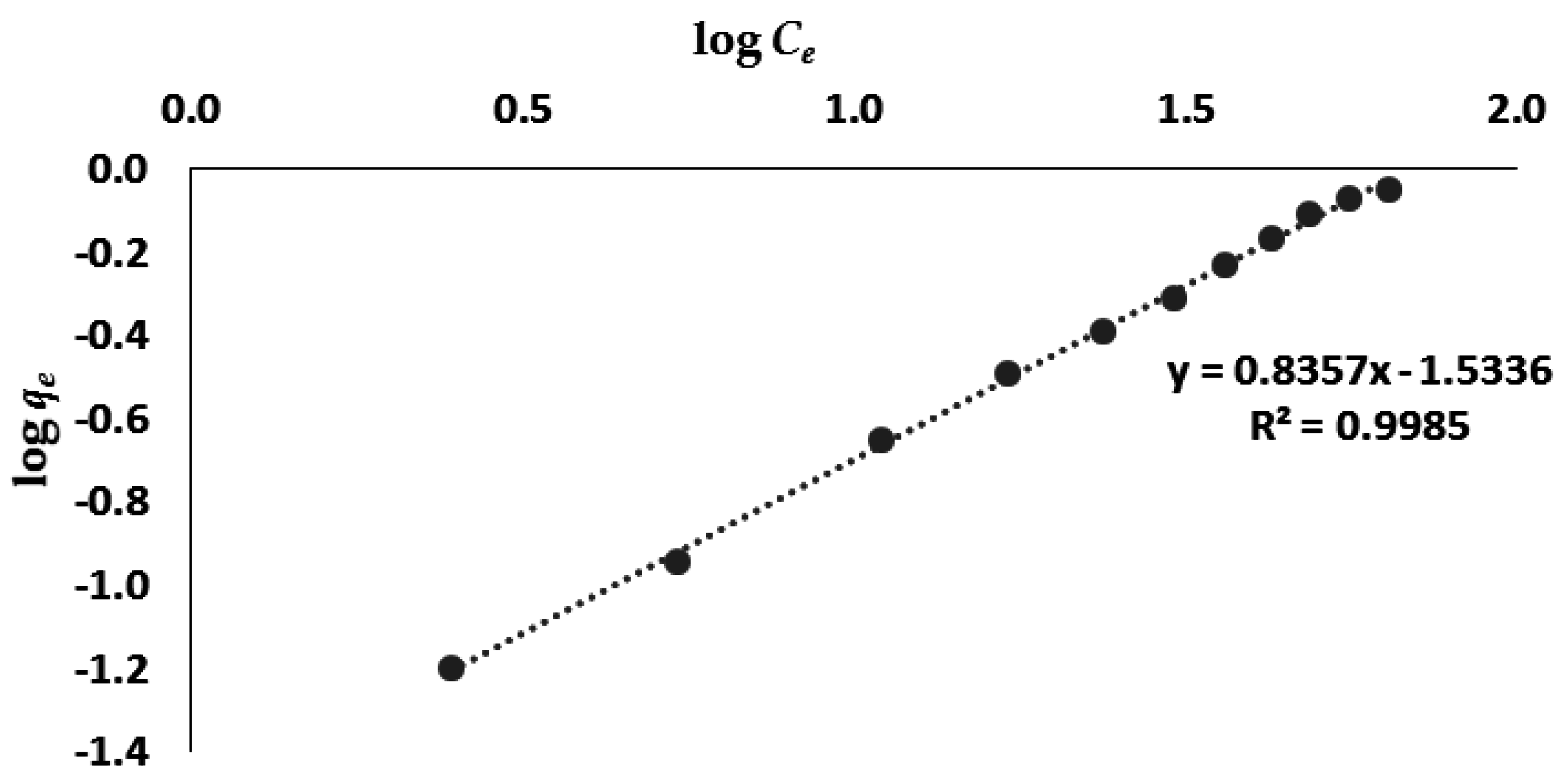

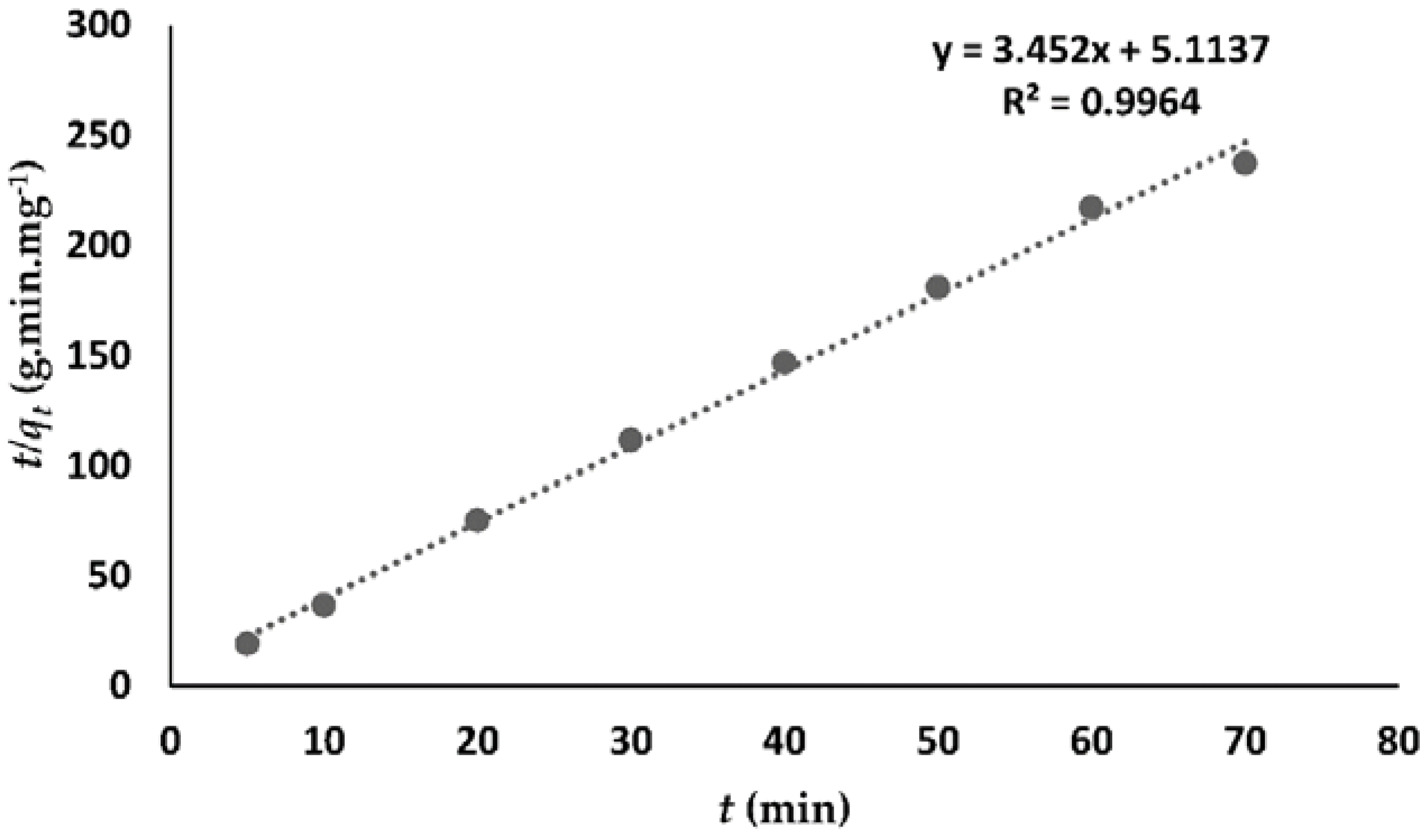

| Adsorbent | Langmuir Isotherm | Freundlich Isotherm | |||||
|---|---|---|---|---|---|---|---|
| qo (mg/g) | KL (L/mg) | R2 | RL | KL (L/mg) | 1/n | R2 | |
| HDTMA-VMT0.2M | 2.3669 | 0.0095 | 0.8902 | 0.9294 | 0.0293 | 0.8357 | 0.9985 |
| Adsorbent | Adsorption Capacity (mg/g) | References |
|---|---|---|
| Magnesium Titanate | 0.03 | [38] |
| Granula acid treated bentonite | 0.094 | [39] |
| Pumice | 0.31 | [40] |
| Zeolite | 0.47 | [41] |
| Regenerated spent bleach earth | 0.6 | [42] |
| Fe/Zr-Alginate microparticles | 0.981 | [43] |
| Gypsiferous limestone | 1.07 | [44] |
| Synthetic Siderite | 1.77 | [45] |
| Hydrous bismuth oxide | 0.06–1.93 | [46] |
| Iron impregnated granular ceramic | 1.70–2.16 | [47] |
| Fe-Al-Ce nanocomposite | 2.22 | [48] |
| CMPNS | 2.3 | [49] |
| Stilbite zeolite modified Fe3+ | 2.31 | [50] |
| HDTMA-VMT0.2M | 2.36 | Present study |
| Adsorbent | qe exp (mg/g) | Pseudo-First-Order Model | Pseudo-Second-Order Model | ||||
|---|---|---|---|---|---|---|---|
| K1 (×103 min−1) | qe cal (mg/g) | R2 | K2 (×10 g·mg−1·min−1) | qe calc (mg/g) | R2 | ||
| HDTMA-VMT0.2M | 0.2950 | 0.0274 | 0.0143 | 0.0069 | 0.6757 | 0.2896 | 0.9964 |
© 2016 by the authors; licensee MDPI, Basel, Switzerland. This article is an open access article distributed under the terms and conditions of the Creative Commons Attribution (CC-BY) license (http://creativecommons.org/licenses/by/4.0/).
Share and Cite
Ologundudu, T.O.; Odiyo, J.O.; Ekosse, G.-I.E. Fluoride Sorption Efficiency of Vermiculite Functionalised with Cationic Surfactant: Isotherm and Kinetics. Appl. Sci. 2016, 6, 277. https://doi.org/10.3390/app6100277
Ologundudu TO, Odiyo JO, Ekosse G-IE. Fluoride Sorption Efficiency of Vermiculite Functionalised with Cationic Surfactant: Isotherm and Kinetics. Applied Sciences. 2016; 6(10):277. https://doi.org/10.3390/app6100277
Chicago/Turabian StyleOlogundudu, Tayo Oladipo, John O. Odiyo, and Georges-Ivo E. Ekosse. 2016. "Fluoride Sorption Efficiency of Vermiculite Functionalised with Cationic Surfactant: Isotherm and Kinetics" Applied Sciences 6, no. 10: 277. https://doi.org/10.3390/app6100277





